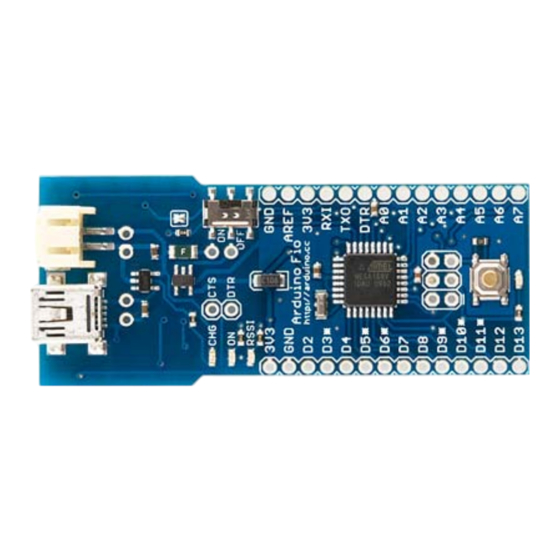
Table of Contents
Advertisement
Quick Links
Arduino - ArduinoBoardFio
Arduino Fio
Overview
The Arduino Fio is a microcontroller board based on the ATmega328P (datasheet (http://www.atmel.com/Images/Atmel-8271-8-bit-
AVR-Microcontroller-ATmega48A-48PA-88A-88PA-168A-168PA-328-328P_datasheet.pdf)) runs at 3.3V and 8 MHz. It has 14 digital
input/output pins (of which 6 can be used as PWM outputs), 8 analog inputs, an on-board resonator, a reset button, and holes for
mounting pin headers. It has connections for a Lithium Polymer battery and includes a charge circuit over USB. An XBee socket is
available on the bottom of the board.
The Arduino Fio is intended for wireless applications. The user can upload sketches with an a FTDI cable or Sparkfun breakout board.
Additionally, by using a modified USB-to-XBee adaptor such as XBee Explorer USB, the user can upload sketches wirelessly. The board
comes without pre-mounted headers, allowing the use of various types of connectors or direct soldering of wires.
The Arduino Fio was designed by Shigeru Kobayashi and SparkFun Electronics, and manufactured by SparkFun Electronics.
Schematic & Reference Design
EAGLE files: arduino-fio-reference-design.zip (http://arduino.cc/en/uploads/Main/arduino-fio-reference-design.zip)
Schematic: Arduino-Fio-schematic.pdf (http://arduino.cc/en/uploads/Main/Arduino-Fio-schematic.pdf)
Summary
Microcontroller
ATmega328P
Operating Voltage
3.3V
Input Voltage
3.35 -12 V
Input Voltage for Charge
3.7 - 7 V
Digital I/O Pins
14 (of which 6 provide PWM output)
Analog Input Pins
8
DC Current per I/O Pin
40 mA
Flash Memory
32 KB (of which 2 KB used by bootloader)
SRAM
2 KB
EEPROM
1 KB
Clock Speed
8 MHz
Width
28 mm
Length
65 mm
Weigth
9 g
Power
The Arduino Fio can be powered with an FTDI cable or breakout board connected to its six pin headers (as marked on the bottom side),
or with a regulated 3.3V supply on the 3V3 pin or a Lithium Polymer battery on the BAT pins.
The power pins are as follows:
Page 1 of 3
Advertisement
Table of Contents

Summary of Contents for Arduino ArduinoBoardFio
- Page 1 Power The Arduino Fio can be powered with an FTDI cable or breakout board connected to its six pin headers (as marked on the bottom side), or with a regulated 3.3V supply on the 3V3 pin or a Lithium Polymer battery on the BAT pins.
- Page 2 ATmega328P provides UART TTL serial communication, which is available on digital pins 0 (RX) and 1 (TX). The Arduino software includes a serial monitor which allows simple textual data to be sent to and from the Arduino Fio board via an external serial connection.
- Page 3 The dimensions of the Fio PCB are approximately 1.1" x 2.6". Related Pages The Arduino Fio can be programmed wirelessly over its XBee radio. See the Arduino Fio Programming (http://arduino.cc/en/Main/ArduinoBoardFioProgramming) page for the details. Because the Fio communicates over XBee radios, the following Sketch-writing tips (http://arduino.cc/en/Main/ArduinoBoardFioTips) will help you avoid unexpected errors.















Need help?
Do you have a question about the ArduinoBoardFio and is the answer not in the manual?
Questions and answers